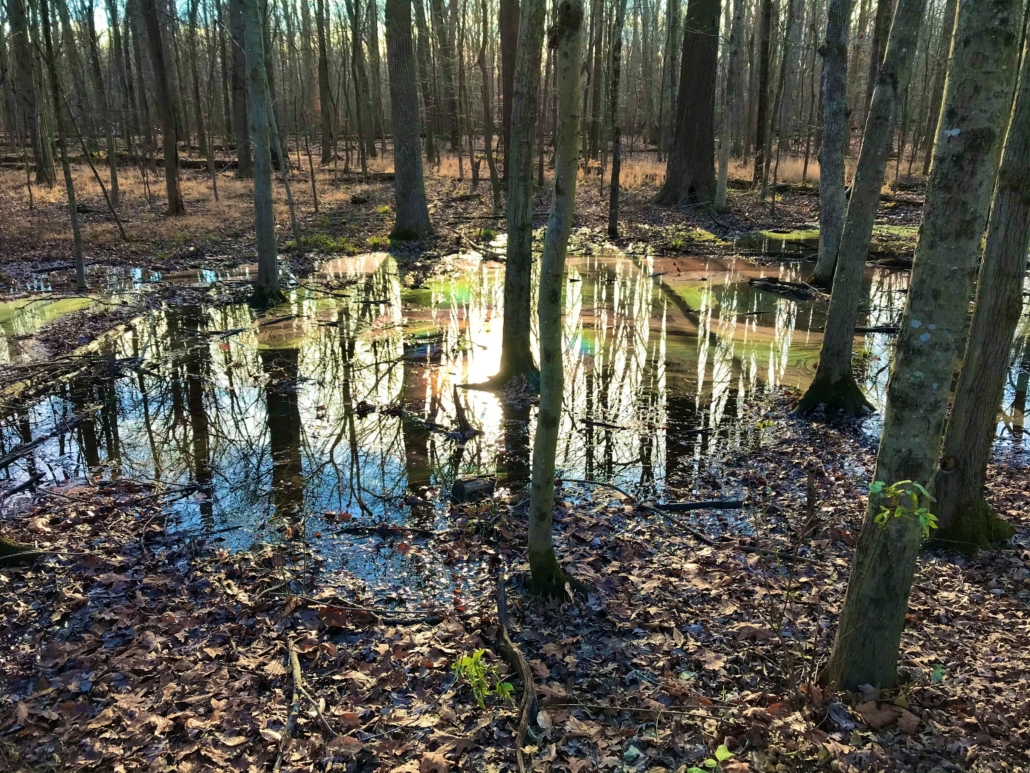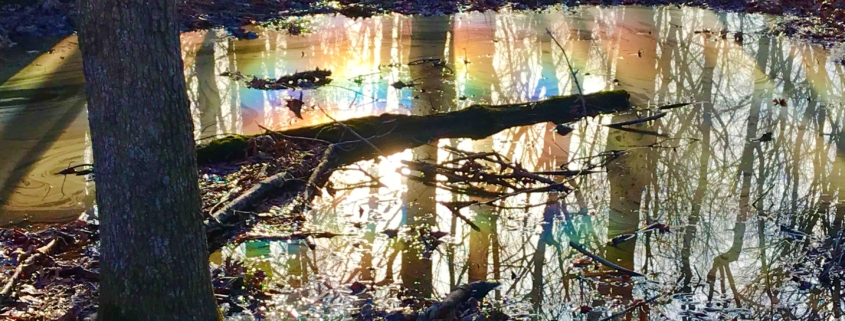Rainbow Pools of Huntley Meadows Park
I am almost certain that most of the FMN newsletter readers have seen or heard of the phenomenon described in this article, commonly called rainbow pools. However, since I recently had my first opportunity, unplanned as it was, to photograph them at Huntley Meadows Park I thought I would share my good fortune. I was returning to the nature center following an afternoon of trail monitoring when conditions came together and gifted me with a fleeting glimpse of this colorful phenomenon. I say fleeting because several conditions need to be met to see the rainbow effect: A. decomposed organic surface slime, B. still waters, and C. just the right angle of sun light. And they were all in convergence as I unsuspectingly walked by; and alas, the effect dissolved in ten minutes as condition C degraded.
They are called rainbow pools because the surface coating on the pools resemble oily layers of red, blue, pink, yellow, purple, and colors that may not have a name. The coating is iridescent too like an oil slick but it disperses when disturbed unlike an oil slick, so disturbing the slick is a good way to test between the two.

These rainbow pools are not a sign of pollution but are instead a natural occurrence in most wetlands. Given a combination of very still waters, a few days without rain or wind to disturb surface tension, and the correct angle of light, nature may provide you with a truly colorful experience. I have seen photos that show much more vibrant colors then in the ones I took. My personal observation is that the darker the water (more tannin) the higher the reflective value of the surface material. In addition, these pools sit among hardwood trees so less oil is exuded in the decomposition process of leaf litter when compared to pine or cypress forests. The pools in this section of the park tend to be temporal and, therefore, are less stained with leached tannins and oils creating a more pastel pallet.

Most often the sheen forms as a result of decaying vegetation, especially from plant materials that exude natural oils, such as pine cones and needles. Another cause can be anaerobic bacteria breaking down iron in the soil. Once the cells begin to decay, they release a reddish slime material, which floats to the surface. Iron bacteria are of no threat to human health. They are found naturally in soils and water in low numbers and will thrive as more iron becomes available. Yet another example of how wetlands are ecologically important systems due to their high plant productivity and their capacity to recycle nutrients. Bacteria in wetland soils break down organic and inorganic structures.
The rainbow effect is typically seen during cooler months and as the sun approaches the lower degrees of an acute angle such as in the morning or as the sun is setting, providing the appropriate reflective angle. The pools pictured in this article are located in the back still waters off the wooded section of Cedar trail at HMP, not in areas near the creeks or other moving water. These photos were taken on 3 December around 3:30 p.m. as I finished an afternoon of trail monitoring. Other pools can be found in other sections of the park.
So you want to chase a rainbow? Try running down a rainbow pool at Huntley Meadows. But running on the boardwalk is not permitted … those trail monitors will get cha.





What a wonderful story, Jerry! Thank you for the treat.
Thanks for sharing !